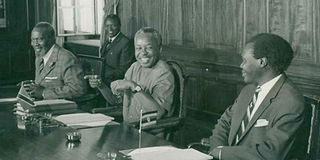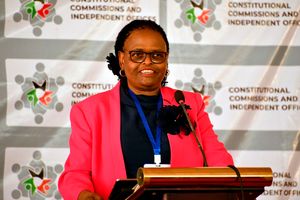Kenyatta-era manoeuvres that still affect Kenya

Presidents from left: Jomo Kenyatta (Kenya), Julius Nyerere (Tanzania) and Uganda’s Milton Obote converse during an East African Community meeting. PHOTO | FILE | NATION MEDIA GROUP
What you need to know:
- The EAC is still a mild form of the East African Federation, which was being pushed by Julius Nyerere and the British to stop Kwame Nkrumah’s bid for a United States of Africa.
- Eduard Zellweger advised Kadu that it could only beat “ethnic domination” of Kikuyu and Luo by insisting on a federal system to guard minorities' interests.
Modern-day Kenya has been trapped in two political experiments that have continued to bother us.
The first is our quest for county governments while the second is the East African Community (EAC).
These two have their origins in proposals and experiments dating back to the 1960s, and whether they make sense is another story.
The EAC is still a mild form of the East African Federation, which was being pushed by Julius Nyerere and the British to stop Kwame Nkrumah’s bid for a United States of Africa.
Had everything gone as planned, Tom Mboya would have eclipsed Jomo Kenyatta in the East African Federation as the future leader of Kenya.
Mboya appeared to have the British support, nay approval, from the outset.
Shortly after Kenya was granted self-government on June 1, 1963, Mboya, Joseph Murumbi, Mbiyu Koinange and Charles Njonjo went to London to meet Colonial Secretary Duncan Sandys.
Unknown to many, it was this group that went to negotiate the actual date of Kenya’s independence and they settled on December 12, 1963.
LEADERS DIVIDED
From minutes tabled at the British Cabinet on June 20, 1963, it appears that Mboya was the leader of the delegation.
He wanted Kenya to join the East African Federation, comprising Kenya, Uganda and Tanganyika. Zanzibar was to join “if it wished”, according to the minutes.
At the continental level, Ghana’s Nkrumah was pushing for a united Africa – of which he would be the leader – and had tried to unite Ghana, Guinea and Mali as his starting point.
Nyerere was opposed to Nkrumah’s approach to African unity and wanted strong regional units.
The two exchanged harsh words and since Nkrumah and Mboya were always at loggerheads over the leadership of trade unions in Africa, it was not surprising that he became the Kenyan face of the proposed East African Federation.
Nkrumah viewed Mboya as a lackey of the West.
Koinange was a friend of Nkrumah, and had been appointed special adviser on African affairs in Ghana’s independent government. He would thus not push the idea of a federation.
As such, it appears that only Mboya was supporting the East African Federation at the London meeting.
FORMIDABLE FIGURES
Would that, then, be the reason Njonjo and Koinange would later help sabotage the rise of the federation?
We don’t know, yet, but Njonjo once told me that when the EAC – the mild form of the federation – collapsed, he went to Norfolk Hotel and drank five glasses of champagne to celebrate.
Njonjo was one of the reluctant supporters of the community – and said as much in Parliament.
As early as 1975, he had advised the government to withdraw from the EAC, describing Tanzania’s socialism as a euphemism for laziness.
I have often heard some arguments that the British had asked Jaramogi Oginga Odinga to take over power rather than wait for Kenyatta.
From the records I have seen, there was no such thing. In the memorandum to the Cabinet written in March 1962, when Jomo was still incarcerated, Reginald Maudling, the Secretary of State for the Colonies, described Mboya as a politician who “genuinely desires to see a civilised Kenya”.
When it comes to Jaramogi, the Cabinet was told – and it agreed – that “old guard of thugs and ex-detainees work with Mr Oginga Odinga, the main beneficiary of the Communist money”.
Maulding continued: “Mr Kenyatta is the accepted leader of the Kikuyu, and although his mental powers are clearly declining, his colleagues openly acknowledge his hold over his tribe and its terrorist organisation remains strong enough for him still to be a most formidable figure, particularly in alliance with Mr Oginga Odinga.”
THE JOMO PROBLEM
Minutes of a Cabinet meeting chaired by Harold Macmillan show that on February 21, 1961, the Cabinet, sitting in Admiralty House, was asked to discuss the future of Jomo Kenyatta after he completed his jail term.
It is now clear they wanted Kenyatta to only return after a new government was in place.
The minutes, marked secret, show there was pressure from the United Nations to have Kenyatta released.
But the governor was of the view that Kenyatta should only be released when a new government was firmly established.
The minutes read: “Meanwhile, he proposed to transfer him to a healthier and less remote locality and, as a means of eroding the exaggerated public conception of his significance, to allow him more frequent visitors, including representatives of the new Council of Ministers, ministers of religion and the press.”
The Cabinet agreed that the governor’s intention be broadcast on February 27, “after the completion of polling… but before the results were announced.”
It is now known that Jomo Kenyatta’s press conference in Maralal on April 11, 1962 was supposed to showcase him as a person who had lost touch with international issues.
BRITAIN'S FOLLY
But he would surprise the journalists, not only with his eloquence but also his grasp of politics and history, much to the chagrin of Maulding, who had organised the media parley.
Had the British listened to the the likes of Fenner Brockway, perhaps the most vocal in parliament against detentions in Kenya, they would not have got it all wrong on Jomo Kenyatta.
Actually, had Britain listened to Brockway, Kenyatta would not have been jailed.
The two, Brockway and Kenyatta, had by the time of Kenyatta’s arrest collected more than 67,000 signatures to petition the House of Commons to address the land question in Kenya – and he told Parliament as much.
Actually, the small group of left-wing politicians who associated with Kenyatta in London were surprised that he could have been a member of the Mau Mau.
When Kenyatta was staying in London, he had become a great friend of James Maxton, a British left-wing politician and pacifist.
MAU MAU ANGLE
Brockway, who knew both, would later say: “James Maxton was very closely associated with Kenyatta. Those who knew James Maxton would agree that he would not become a colleague and comrade of someone who was vicious in nature.
We found Kenyatta utterly devoted to the cause of African freedom. He had a brilliant mind. He was one of the ablest students at the London School of Economics, where he was praised by the Professor of Anthropology. He wrote his thesis and it was published in book form. He was always good fun.
“I am very doubtful about Kenyatta’s guilt and responsibility for Mau Mau. I am doubtful because, in the years when he was supposed to be organising Mau Mau, I was in Kenya and was cooperating with him in constitutional, democratic political activities.
We were then planning together a great petition to this House of Commons on the land question, a petition that was signed by 67,000 Africans in Kenya. I find it difficult to believe that if Jomo Kenyatta was at that time thinking of a Mau Mau organisation to murder and massacre the European population, he was also conducting propaganda among his own people to ask them to look to the House of Commons and to political and constitutional means.”
These details were ignored by the British press, which was pushing the narrative of Kenyatta as the leader of Mau Mau. And because they did not like the emergence of Kenyatta, they would later overlook it as Kenya adopted a majimbo (federalism) constitution which, they concurred internally, would not work.
MAJIMBO DEBATE
If you read the British press, then you might think regionalism was being supported fully as proposed by the Kenya African Democratic Union (Kadu).
But the British archival minutes show a different story and the British Cabinet was at one point told by Colonial Secretary Reginald Maulding that the majimbo ideas were being influenced by a Swiss constitutional expert.
“While no doubt workable in Switzerland, (these proposals) make no sense in Kenya. They have been determined to erect what they call defence in depth by dividing Kenya into six regional states with legislative and administrative powers on a large scale, and further by insisting on a second chamber with powers equal to that of the federal lower house,” he said.
That Swiss expert, who apparently is the father of regionalism – and the counties’ idea in Kenya – was Dr Eduard Zellweger, a man who is rarely mentioned in political circles.
But if you look at the events of 1960s, Dr Zellweger was a common thread in the majimbo talks – the way Yash pal Ghai influenced the 2010 Constitution.
He advised Kadu that it could only beat “ethnic domination” of Kikuyu and Luo by insisting on the Swiss-style federal system to safeguard the interests of the minority.
COUNTY GOVERNMENTS
Although the British had no time for Zellweger, and Cabinet records show as much, they did little to stop the experiment favoured by the colonial settlers as the best safeguard of their interests.
The Colonial Secretary had deep misgivings about Kadu’s Ronald Ngala and Daniel arap Moi’s push for regionalism.
“While their proposals might protect local interests, this is not to my mind certain: on the other hand, it is quite clear that, from the point of view of practical administration, they make little sense.
Unfortunately, Kadu’s tactics throughout have been to be as intransigent as possible, and as such concessions as they have made have been very small and wrung from them by a process like extracting teeth.”
Again, whether Zellweger’s ideas later metamorphosed into the modern-day county governments is a matter that should be left to political scientists and historians, but what we know is that he took advantage of a disorganised Kadu to push his ideas.
These experiments continue to haunt the nation.
[email protected]; @johnkamau1





